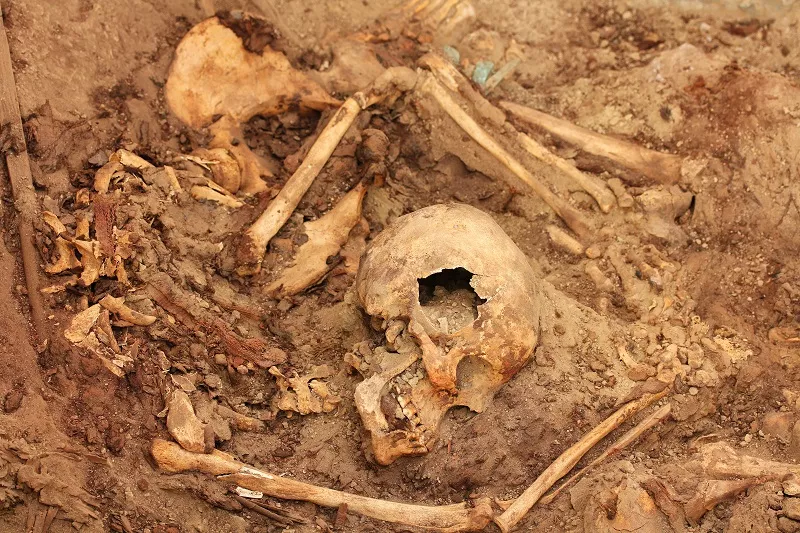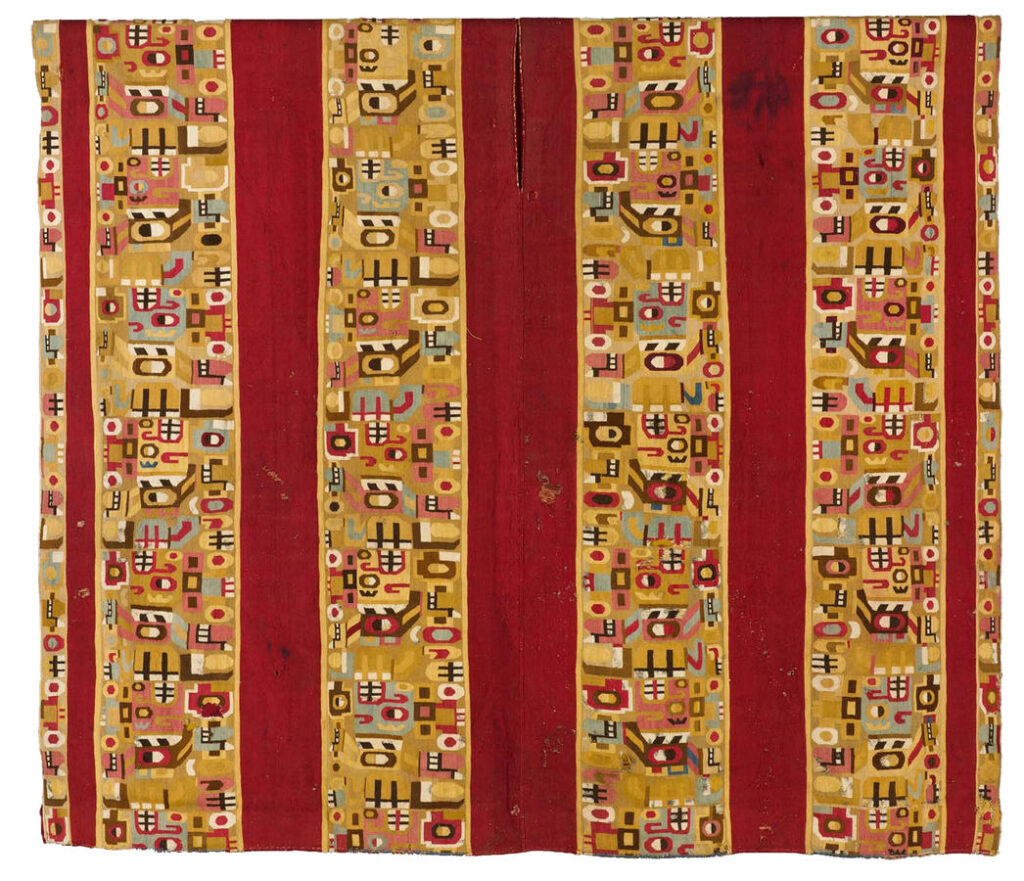អរិយធម៌វ៉ារី (Wari) ឬ ហ៊ូរី (Hauri) គឺជាអរិយធម៌ចំណាស់មួយក្នុងចំណោមអរិយធម៌ចំណាស់ទាំងបីក្នុងតំបន់ជ្រលងភ្នំអេនឌៀន (Andean) រួមមាន៖ អរិយធម៌ឆាវិន អរិយធម៌វ៉ារី និងអរិយធម៌ទីវ៉ាណាគុ។ អរិយធម៌វ៉ារី មានការរីកចម្រើនខ្លាំងនៅអំឡុងស.វ.ទី៧ នៃគ.ស. នៅតាមតំបន់ឆ្នេរ និងតំបន់ខ្ពង់រាបនៅក្នុងប្រទេសបេរ៉ូ។ ហ៊ូរី ត្រូវបានគេដឹងថា ជារាជធានីនៃអរិយធម៌វ៉ារី ហើយទីក្រុងនេះស្ថិតនៅប្រមាណ១៧៥គីឡូនៅភាគខាងជើងពីរាជធានីលីម៉ា នៃប្រទេសបេរ៉ូបច្ចុប្បន្ន។ ទីក្រុងនេះ មានកំពែងដី និងបង្ហាញពីសំណង់នៃអរិយធម៌ដែលនៅតាមជ្រលងភ្នំអេនឌៀន (Andean) ដែលរួមមានសំណង់ប្រាសាទ និងរចនាសម្ព័ន្ធសារធារណៈផ្សេងៗ។ តំបន់ខាងជើងនៃទីក្រុងហ៊ូរីនេះត្រូវបានអ្នកស្រាវជ្រាវបង្ហាញថា ជាតំបន់ដែលមានមនុស្សរស់នៅចាស់ជាងគេ ហៅថា Vegachayoq Moqo។
អ្នកស្រាវជ្រាវបានរកឃើញផ្នូរជាច្រើននៅតំបន់ពីរសំខាន់ ដែលជាកន្លែងរស់នៅ និងស្ថានីយកប់សពរបស់មនុស្សក្នុងអរិយធម៌វ៉ារីនេះដែលឃើញមាននៅតំបន់ El Castillo de Huarmey និងតំបន់ Huaca Santa Rosa de Pucala។
កាលពីឆ្នាំ២០១២ អ្នកស្រាវជ្រាវបុរាណវិទូជនជាតិបេរ៉ូ និងអ្នកស្រាវជ្រាវបរទេស បានរកឃើញនូវគ្រោងឆ្អឹងមនុស្សជាច្រើនដែលគេយល់ថា ជាផ្នូរសពក្នុងអរិយធម៌វ៉ារី នៅក្នុងតំបន់ El Castillo de Huarmey ដែលមានចម្ងាយប្រមាណជាង១៧០គីឡូ ភាគខាងជើងនៃរាជធានី លីម៉ា ប្រទេសបេរ៉ូ។ ការរកឃើញនោះ គឺបានផ្តល់ព័ត៌មានថ្មីជាច្រើនលើប្រធានបទនៃការសិក្សាលើអរិយធម៌វ៉ារី ឬអាណាចក្រវ៉ារី ដែលត្រូវបានគេដឹងថា ជាសម័យកាលមុនអរិយធម៌អ៊ីនកា។ អ្នកស្រាវជ្រាវបានរកឃើញគ្រោងឆ្អឹងមនុស្សប្រមាណ៦០នៅក្នុងស្ថានីយនេះ ក្នុងនោះរួមមានគ្រោងឆ្អឹងចំនួន៣ដែលប្រហែលជាផ្នូរនៃក្សត្រីអរិយធម៌វ៉ារី (Wari queens buried ) ដែលបញ្ចុះជាមួយនឹងគ្រឿងអលង្ការ អំពីមាស ប្រាក់ និងកុលាលភាជន៌ប្រណីតផ្សេងៗទៀត។ ការរកឃើញទាំងអស់នេះ គឺជាការរកឃើញដំបូងនៃគ្រោងឆ្អឹងទាំងមូល រួមបញ្ចូលទាំងវត្ថុសំណែនផ្សេងៗទៀត។ តាមរយៈការសិក្សា លើកុលាលភាជន៌អ្នកស្រាវជ្រាវបានបង្ហាញថា ផ្នូរនោះមានអាយុកាលប្រមាណជាង១២០០ឆ្នាំ និងកាលពីថ្មីៗនេះអ្នកបុរាណវិទូជនជាតិបេរ៉ូក៏បានរកឃើញគ្រោងឆ្អឹងមនុស្សចំនួន២៩នាក់ ដែលរួមមានក្មេងចំនួន៣នាក់នៅក្នុងតំបន់ Huaca Santa Rosa de Pucala ដែលមានចម្ងាយប្រមាណជាង៧៥០គីឡូម៉ត្រ ខាងជើងពីរាជធានី លីម៉ាប្រទេសបេរ៉ូ។ តាមរយៈការសិក្សាវិភាគ អ្នកស្រាវជ្រាវបានបង្ហាញថាគ្រោងឆ្អឹងទាំងនោះស្ថិតនៅក្នុងអរិយធម៌វ៉ារី ដែលមានអាយុកាលប្រមាណជាង ១០០០ឆ្នាំ។ គួរបញ្ជាក់ដែរថា ស្ថានីយនេះក៏ជាតំបន់នៃបណ្តុំប្រាសាទនៃអរិយធម៌វ៉ារីដែរ ហើយក៏បន្តរហូតដល់អរយិធម៌អ៊ីនកា។
ក្រៅពីស្ថានីយកប់សពទាំងពីរខាងលើ តំបន់សំខាន់ៗនៃអរិយធម៌វ៉ារីមានផ្សេងៗទៀតដូចជានៅ Pikillacta គឺជាទីក្រុងសំខាន់មួយទៀត ដែលស្ថិតនៅខាងត្បូងនៃទីក្រុងហ៊ូរី ហើយទីក្រុង Pikillacta នេះត្រូវបានកសាងនៅពាក់កណ្តាលស.វ.ទី៧នៃគ.ស. នៅតំបន់ Viracochapampa, Jincamocco, Conchopata, Marca Huamachuco, និង Azangaro ដែលជាប់នឹងតំបន់ Tiwanaku (អរិយធម៌ Tiwanaku)។
តាមរយៈការរកឃើញនូវសំណង់ស្ថាបត្យកម្ម និងវត្ថុសិល្បៈផ្សេងៗ បានបង្ហាញថាមនុស្សក្នុងអរិយធម៌នេះមានជំនាញខ្ពស់ក្នុងការផលិតវត្ថុសិល្បៈ តាមទម្រង់ផ្សេងៗដែលបានរកឃើញពីកន្លែងជាច្រើននៃអរិយធម៌នេះរួមមាន គ្រឿងស្មូនដី គ្រឿងអលង្ការ គំនូរលើរូបចម្លាក់ដី និងគំនូរលើក្រណាត់។ ម្យ៉ាងទៀតគេស្គាល់អរិយធម៌វារី គឺតាមរយៈការសិក្សាវិភាគលើគ្រោងឆ្អឹង សំណង់សិល្បៈ និងស្ថាបត្យកម្មនានា ដែលបានរកឃើញដោយក្រុមបុរាណវិទូជនជាតិបេរ៉ូ និងអ្នកស្រាវជ្រាវបរទេស។
សរុបមកអរិយធម៌វារី គឺជាអរិយធម៌មួយមានអាយុកាលចំណាស់ទី២ ក្នុងចំណោមបណ្តាអរិយធម៌ទាំងបីក្នុងតំបន់ជ្រលងភ្នំអេនឌៀន។ អរិយធម៌ Andean គឺជាបណ្តុំនៃអរិយធម៌ដែលកកើតនៅតាមបណ្តាយតំបន់ជ្រលងភ្នំ Andes ដែលលាតសន្ឋឹងក្នុងប្រទេសតំបន់អាមេរិកខាងត្បូង។ ដោយឡែកអរិយធម៌វ៉ារីនេះ មានអាយុកាលចាប់ពីស.វ.ទី៧នៃគ.ស. ដល់ស.វ.ទី១១នៃគ.ស. (៦០០ឆ្នាំ នៃគ.ស. រហូតដល់១០០០នៃគ.ស.)។ ម៉្យាងទៀត អរិយធម៌វ៉ារី មានការរីកចម្រើនខ្លាំងនៅអំឡុងស.វ.ទី៧ នៃគ.ស. ពិសេសតាមតំបន់ឆ្នេរ និងតំបន់ខ្ពង់រាបនែប្រទេសបេរ៉ូ៕
———————————————————–
Wari Civilization
The Wari or Hauri civilization is one of the three oldest civilizations in the Andean Valley, including the Chavin civilization, the Wari civilization, and the Tiwanaku civilization. Wari civilization flourished during the 7th century AD in the coastal and plateau areas of Peru. Hauri is known as the capital of the Wari civilization and is located about 175 km north of Lima City, Peru. This city has earthen ramparts and indicated the structures of civilization in the Andean Valley, including temples and public structures. The northern part of the Hauri city has been identified by researchers as the oldest inhabited area called Vegachayoq Moqo.
Archaeologists have unearthed graves in two major areas of human settlements and burial sites in the Wari civilization, found in the areas of El Castillo de Huarmey and Huaca Santa Rosa de Pucala.
In 2012, Peruvian archaeologists and other foreign researchers unearthed human skeletons believed to be those of the Wari civilization in the El Castillo de Huarmey area, more than 170 km north of Lima city, Peru.
All of these findings provide a wealth of information on the subject of the study of the Wari civilization or Wari Empire, known as the pre-Inca civilization. Researchers have found about 60 human skeletons on this site, including three that may have been the tombs of the Wari queens buried with jewelry (gold and silver) and other luxury ceramics. These findings are the first findings of an entire skeleton, including other items for worship. Based on the study on ceramics, researchers can be identified that the tomb is more than 1,200 years old, and also Peruvian archaeologists have recently unearthed 29 human skeletons, including three children, in the Huaca Santa Rosa de Pucala area, more than 750 km north of Lima city, Peru. Through analysis, researchers have shown that the skeletons are in the Wari civilization, which is more than 1,000 years old. It should be noted that this site is also the area of the temple complex of the Wari civilization and also continued until the Inca civilization.
In addition to the two burial sites above, other important areas of Wari civilization, such as Pikillacta, were another major city south of the city of Haori, and Pikillacta was built in the middle of the 7th century In the areas of Viracochapampa, Jincamocco, Conchopata, Marca Huamachuco, and Azangaro that adjacent to Tiwanaku area (Tiwanaku civilization).
Based on the discovery of architectural structures and artifacts shows that people in this civilization are highly skilled in the production of art objects in various forms found in many parts of this civilization, including tool making ceramics, jewelry, paintings on earthware sculptures, and paintings on canvas. Wari civilization is also known through its analysis of skeletons, art structures, and architecture discovered by Peruvian archaeologists and foreign researchers.
Overall, the Wari civilization is the second oldest of the three civilizations in the Andean Valley. Andean civilization is a collection of civilizations that originated in the Andes Valley, which stretches across South American countries. In particular, this Wari civilization dates from the 7th century to the 11th century (600 AD to 1000 AD). On the other hand, the Wari civilization flourished during the 7th century AD, especially in the coastal areas and highlands of Peru.
អត្ថបទដើម៖ លោក អេង តុលា











